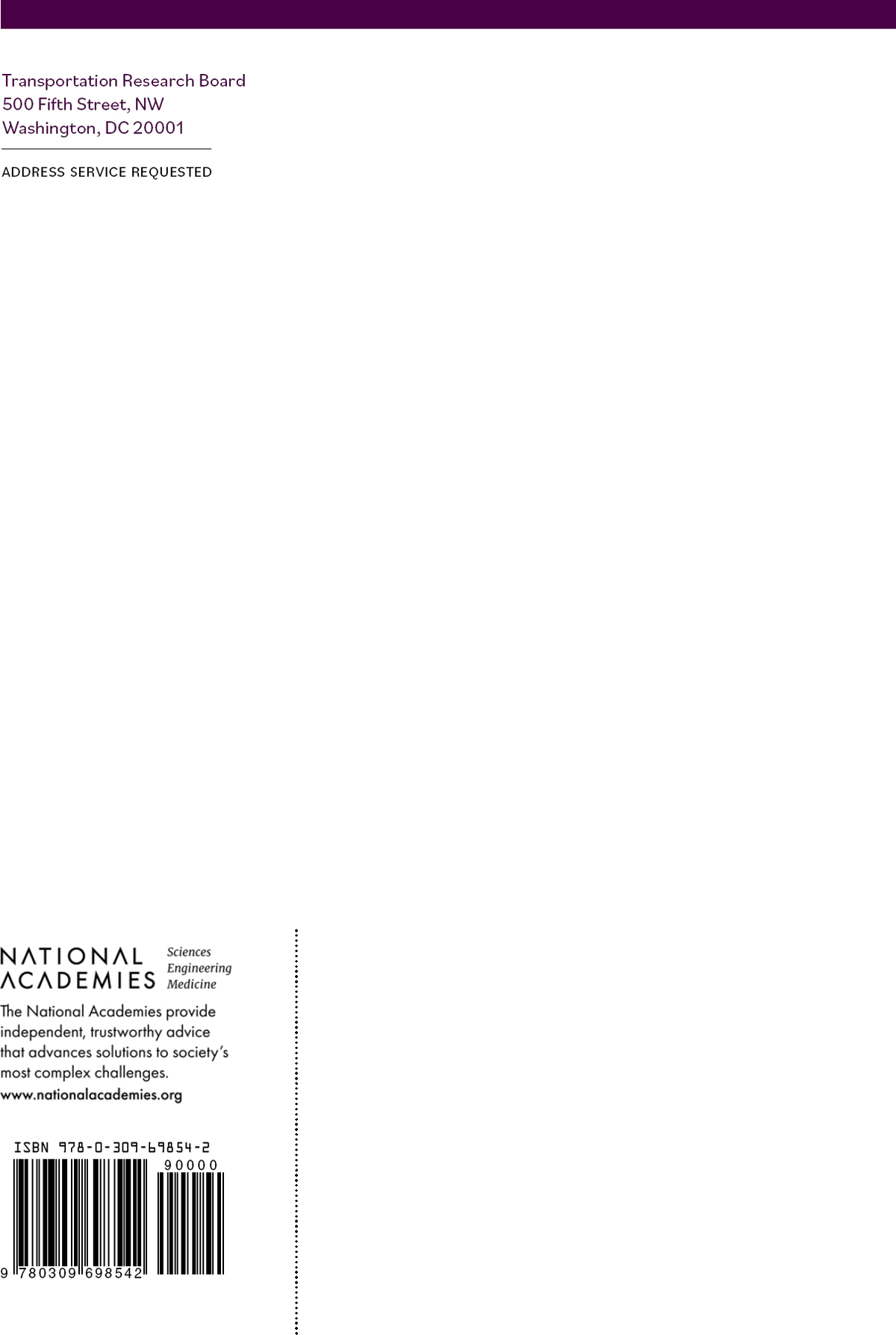
APPENDIX C
Findings of the Survey
Introduction
This appendix presents the detailed findings of the research project’s survey of transit agencies providing an alternative service. Findings are provided under two headings—those related to the key issues for the research project and those that provide additional details on the alternative service programs.
Where appropriate, we supplement survey findings with information obtained from our interviews with five alternative service providers. These include the two prominent TNCs, an “adaptive” TNC, a large taxi company, and a transportation broker managing a large alternative service for a metro region.
Survey Administration and Response
The survey was provided as an online questionnaire using SurveyMonkey (Figure C-1) and sent to 24 transit agencies known to have an alternative service for ADA paratransit riders. Responses were received from 18 of the 24 transit agencies, a response rate of 75%. Note that not all respondents provided an answer to all questions.
Survey Findings: Key Research Issues
What Were the Goals of the Alternative Service?
The primary goals reported, as shown in Figure C-2, include:
- Reduce overall cost and/or unit cost per trip of transporting paratransit customers
- Provide an on-demand/same-day mobility option for paratransit customers
- Reduce demand for paratransit service
Data displayed in Figure C-2 is provided in table format in the “Data Tables for Bar Charts” section of this appendix.
Challenges When Planning and Implementing an Alternative Service
Responding transit agencies reported a number of barriers, risks and legal considerations as key challenges when planning and implementing their alternative service; see Figure C-3. Data for Figure C-3 is shown as a table in the “Data Tables for Bar Charts” section.
As reported, the challenges relate to the regulatory framework as well as to such concerns as finding a local taxi provider with WAVs. Information from the survey on challenges is particularly useful as we consider topics to emphasize in the study’s final toolkit deliverable.
The challenges related to the regulatory framework are discussed in more detail below.
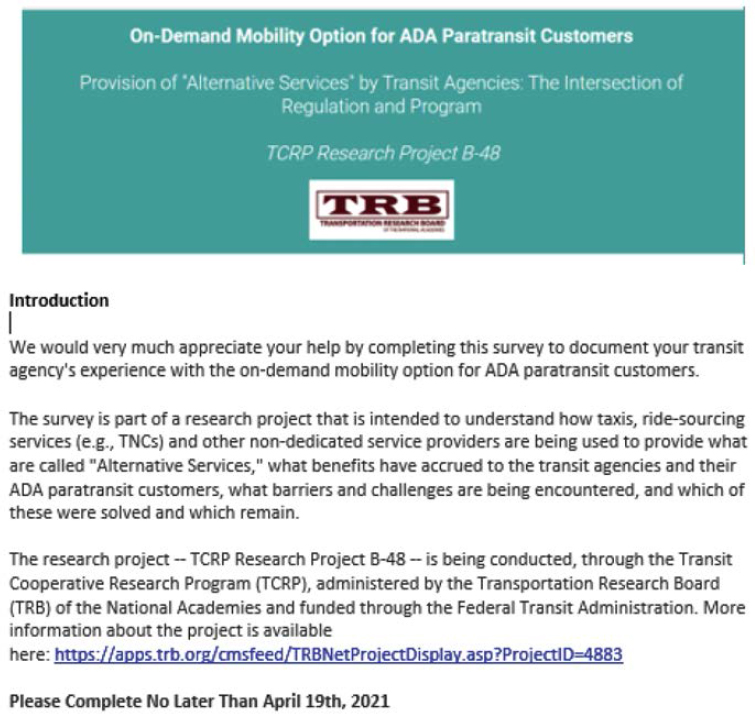
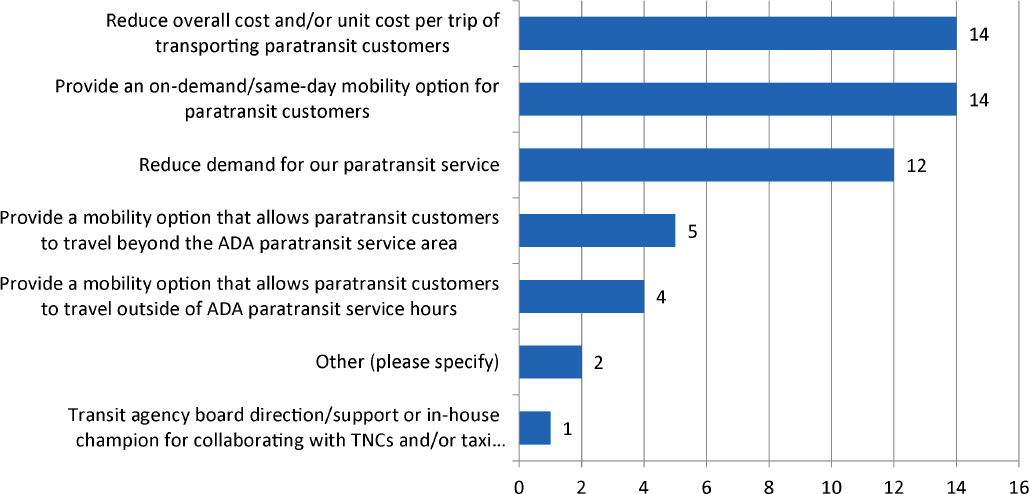
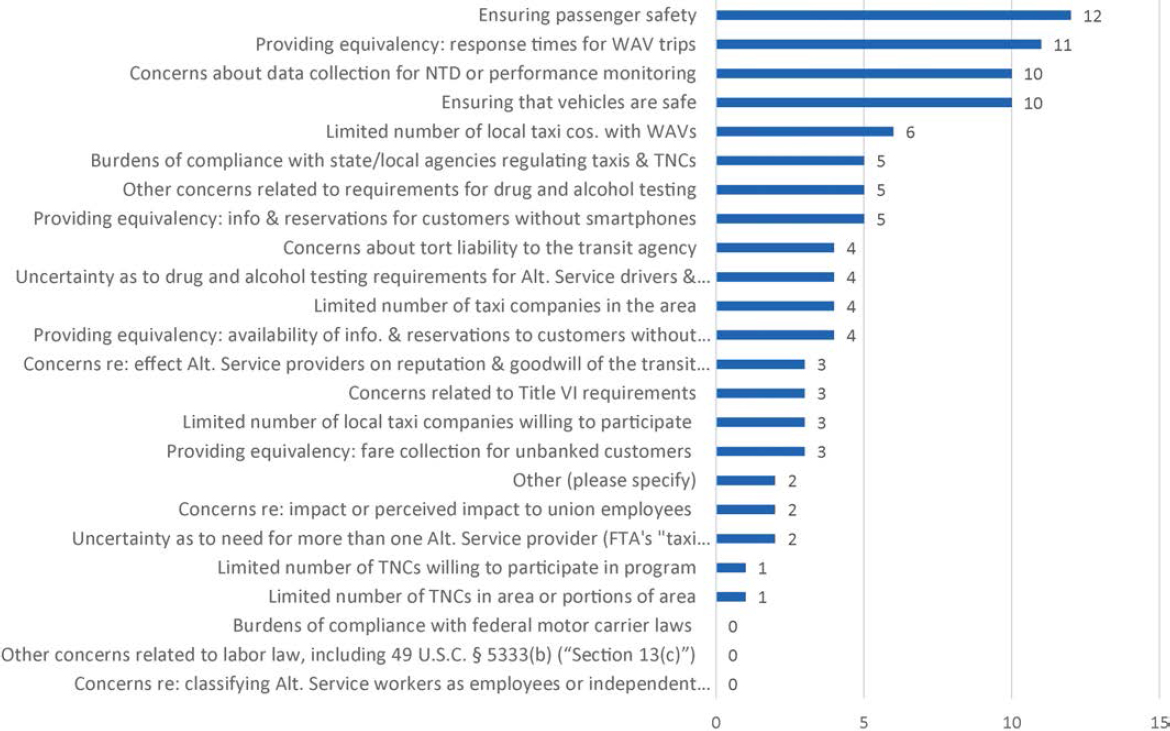
Challenges Related to the Regulatory Framework
ADA Requirements
ADA regulations for public transit agencies are many and prescriptive; some apply to alternative services, and some do not.
Findings from the Survey
Transit agencies responding to the project’s survey indicated various and considerable concerns with meeting ADA’s equivalent service requirements as presented below. In addition, two transit agencies also reported “Other concerns” about meeting ADA requirements.
One of these two transit agencies did not specify the particular “other” ADA concern, while the second reported concerns related to the ADA’s requirement that a directly contracted service contractor “stands in the shoes” of the transit agency. In other words, there were concerns as to whether the alternative service contractor was required to meet the service-related requirements that the transit agency must follow as if it was operating the service itself.
Findings from Provider Interviews
One of the alternative service providers reported that meeting the various regulations, not only federal regulations related to the ADA but in some cases state and local regulations as well, was a challenge. Navigating regulations and requirements can be difficult—“it’s a complex web,” according to the provider. With an effort to better understand some of the regulations, this provider met with an FTA representative to discuss some of the ADA and FTA requirements.
ADA’s Service Equivalency Regulations for Demand Response Transportation
Findings from the Survey
According to the project’s survey, providing equivalent service including equivalent response times for riders using a wheelchair who require an accessible vehicle was the second most frequently cited challenge faced by the transit agencies when planning and implementing their alternative service—with more than two-thirds of the respondents reporting this concern.
While less frequently identified, equivalency concerns related to service for riders without a smartphone, Internet access, or a credit or debit card were reported by a number of the transit agency respondents. These concerns relate to requirements under Title VI, discussed below.
Findings from Provider Interviews
Providing equivalent service for riders needing a WAV was one of the key topics discussed during interviews with providers of alternative services. Each of the five providers interviewed provide WAV service as part of their agreement with the sponsoring transit agency, in several cases through subcontracts with NEMT providers. One of the TNCs has used a contract with one of the large national contractors to serve WAV trips. The one taxi company interviewed has a significant number of WAV taxis in service, in keeping with the regulatory mandate established by the county where the company operates.
Regarding response time for WAV trips, one of the TNCs uses a two-hour response time for all trips and another provider is thinking it may recommend that approach to its main transit agency client. This approach delays the response time for sedans while giving more time for the WAV vehicles to respond, which are fewer in number, and helps work toward equivalent response time. Interestingly, one of alternative service providers operating in a large metro area reported that response times for non-WAVs and WAVs are currently practically equal since the TNCs lack drivers, so that response times for TNC trips are considerably longer than pre-COVID.
The two major TNCs report that they provide data on response time, specifically between non-WAV and WAV trips, to their transit agency clients. The TNC using the two-hour response time reported that it specifically monitors response times between non-WAV and WAV trips, with data available, but stated that it’s not clear if the transit agencies have requested that level of data detail. The taxi company interviewed reported that its transit agency client has not required such response time data.
Title VI
Findings from Survey
Six of the transit agency survey respondents reported concerns related to Title VI and its requirements. These transit agencies reported a concern specifically with meeting requirements of Title VI in general and/or reported concerns with ensuring equivalent service for those without a smartphone, without access to the Internet or who are unbanked.
Findings from Provider Interviews
According to the provider interviews, all five alternative service providers, including the taxi company, have at least two methods for riders to book trips—through a call center and through an app. Two of the providers use third-party call centers outside the U.S. The two prominent TNCs do not have centralized national call centers currently but are moving toward that.
Regarding trip payment, the TNCs typically allow use of prepaid debit cards for those riders who are unbanked. Several of the providers have coordinated fare payment with the transit agency in some cases—and this includes the taxi company—so that riders can use their agency-based accounts to pay for trips on the alternative service.
One of the TNCs expressed concerns that it cannot accept cash. Some state TNC regulations prohibit the TNCs from accepting cash payment, and this TNC believes that prohibition is not fair. A more equitable approach would allow riders to pay in cash in addition to credit/debit cards, according to the TNC.
FTA Drug and Alcohol Testing Requirements
Findings from the Survey
Five transit agency respondents to the survey reported uncertainty regarding requirements for drug and alcohol testing. Two transit agencies indicated uncertainty as to the need for more than one alternative service provider to provide riders a choice to meet FTA’s taxi exemption. One of these two when queried during follow-up indicated it was not so much uncertainty but a push during planning to ensure more than one provider available to provide rider choice.
Findings from Provider Interviews
One of the alternative service providers conducts drug and alcohol testing for its drivers in most cases. According to the interview, the objective of the testing is this company’s focus on safety as well as service targeted to ADA paratransit riders.
National Transit Database
Findings from the Survey
Concerns related to NTD data reporting or performance monitoring were the third most frequently reported challenge by transit agency respondents to the project’s survey.
A related question later in the survey asked the transit agencies if the data they tracked and/or was provided by their alternative service providers were included in the transit agency’s NTD report under purchased transportation service. Findings showed close to half of the respondents said yes; three said no; with the remaining indicating uncertainty or they left the question unanswered.
Related survey findings on data for alternative services are discussed below under Data and Data Sharing.
Federal Labor Laws
Findings from the Survey
Two transit agencies responding to the project’s survey reported concerns about the impact or perceived impact to employees represented by unions.
No transit agency respondent reported any concerns regarding federal labor laws, including Section 13 (c) nor any concerns about the classification of alternative service workers as employees or independent contractors.
Federal Motor Carrier Act of 1935
Findings from the Survey
No transit agency respondent to the survey reported any concerns or burdens of compliance with federal motor carrier laws that regulate interstate carriers and the services they provide.
Other Challenges
Safety
Ensuring safe service for riders is typically a primary objective for public transit agencies, and the survey findings show it is also a primary focus for alternative services.
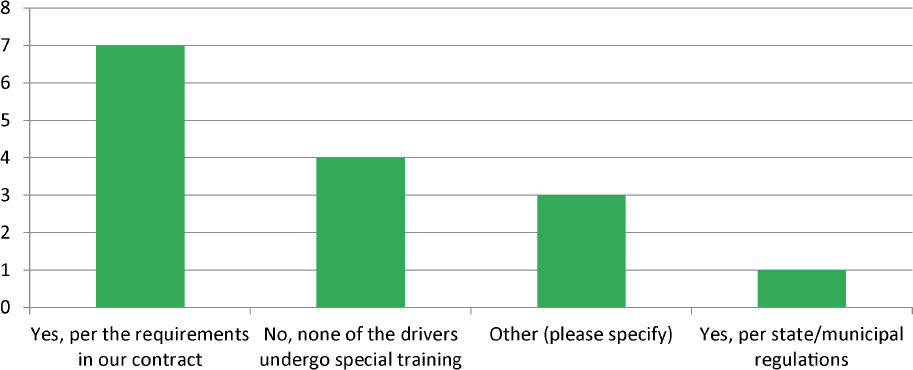
Transit agency survey respondents indicated that safety considerations were a key challenge when planning and implementing their alternative service: ensuring passenger safety was the most frequently reported challenge and ensuring safe vehicles was the third most frequently reported challenge.
Safety for transit riders can be supported with such strategies as driver training, drug and alcohol testing for drivers, and fingerprint background checks. Adequate insurance is another measure related to safety. Survey questions addressed these topics, with findings shown below.
Driver Training.
Are drivers providing alternative services required to participate in any special training programs? Figure C-4 provides the responses. Data for Figure C-4 are provided in table format in the “Data Tables for Bar Charts” section.
Drug and Alcohol Testing.
Are drivers providing alternative service required to participate in drug and alcohol testing programs? Figure C-5 depicts the responses and is provided in table format in the “Data Tables for Bar Charts” section.
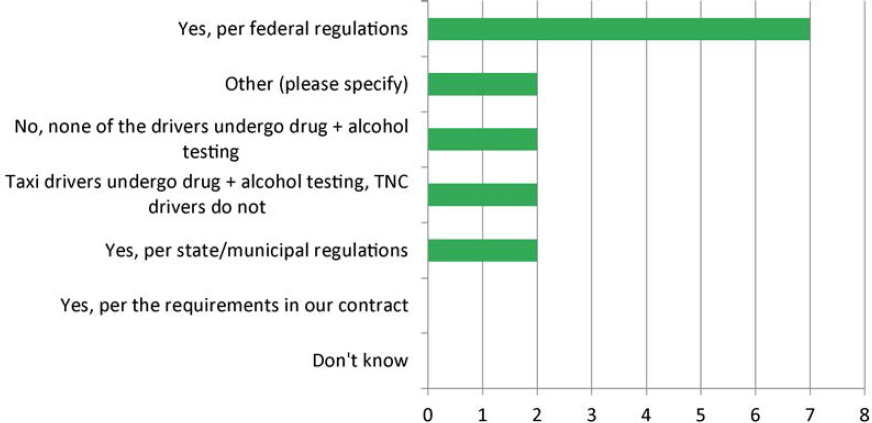
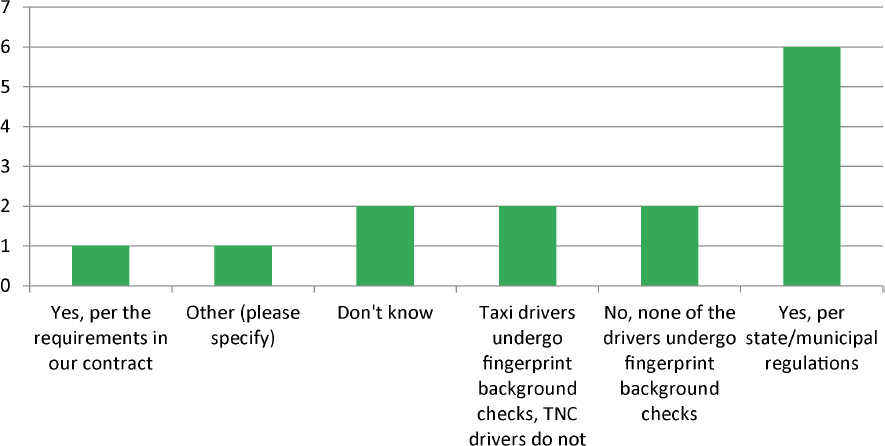
Fingerprinting.
Are drivers providing Alternative Services required to undergo fingerprint background checks? See Figure C-6, and the corresponding table in the “Data Tables for Bar Charts” section.
Insurance.
Does your alternative service contract/agreement require vehicle insurance coverage beyond what is required by the state or municipal regulatory body? See Figure C-7 and the table in the “Data Tables for Bar Charts” section. Among the “Other” responses was “We asked for $2 million, two providers gave that and one gave $200k.”
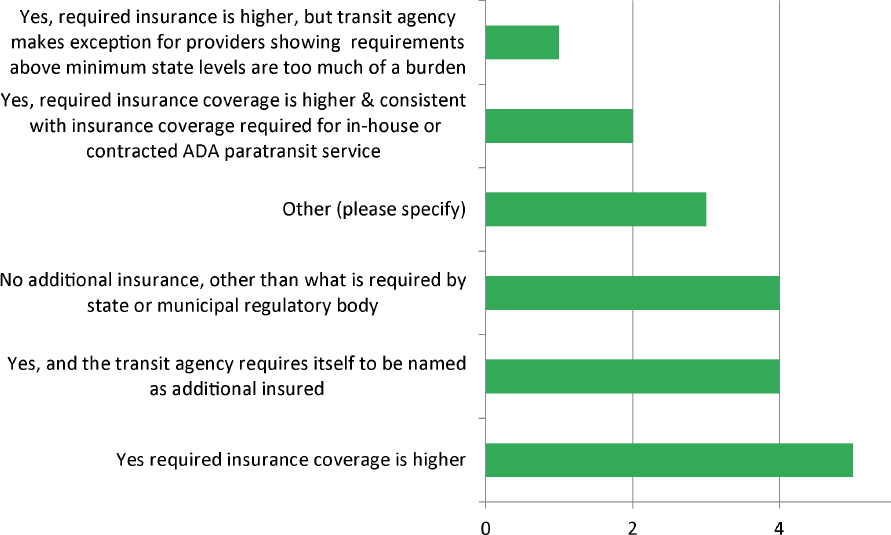
Findings from Provider Interviews.
We asked the alternative service providers during the interviews if they had any concerns or issues regarding insurance requirements established by their transit agency clients. Among the responses include:
- “No issues, most transit agencies accept the insurance levels we provide.”
- “If the required insurance levels are particularly high, we have to make a business decision as to whether it makes sense to pursue the work.”
- From the taxi company, “the transit agency accepts the insurance levels set by our county’s taxi regulations.”
Availability of Alternative Service Providers
The survey listed five potential barriers, risks or legal considerations focusing on efforts to find alternative service providers that may have posed a challenge when planning and implementing the program.
Of these possible challenges, the one concern cited most frequently was a limited number of taxi companies in their area with wheelchair-accessible taxis. This concern supports other survey findings that show attention on ensuring service for ADA paratransit riders who use wheelchairs.
Responses included:
- Limited number of local taxi companies in the area with wheelchair-accessible taxicabs: 6 responses
- Limited number of local taxi companies in the area: 4 responses
- Limited number of local taxi companies willing to participate in the program, e.g., reluctance due to high insurance coverage requirements or other transit agency requirements or issues: 3 responses
- Limited number of TNCs in the area or portions of the area: 1 response
- Limited number of TNCs willing to participate in the program, e.g., reluctance due to high insurance agency requirements, reporting challenges versus data privacy issues, or other transit agency requirements or issues: 1 response
State and Local Regulations on Taxis and TNCs
Five transit agencies reported that burdens of compliance with state and local agencies regulating taxis and TNCs were a challenge when planning and implementing their alternative service.
- Two of the five are in areas with significant taxi regulations.
- Another two are in Florida.
Concerns about Tort Liability
Four transit agencies reported concerns about tort liability to the transit agency.
- Two of these agencies operate in a large metro area and one operates in California.
But What Is Tort Liability?
Tort liability is among the legal issues that public transit agencies and particularly their legal counsel must address. A tort is an act or omission—negligent, intentional, or otherwise—by a person or organization that causes injury or harm to another, and for which courts may assign liability and assess damages as a remedy. The word tort comes from the French for “twisted” (e.g., distort, contort), and came to mean “a wrong.”
Related to tort liability is the legal concept of duty of care, which is the responsibility of a person or organization to avoid certain acts or omissions that could reasonably be foreseen to cause harm to others. For a transit agency, a duty of care could include, as one example, ensuring that
wheelchair lifts are well-maintained and functioning properly so as not to malfunction and cause harm to a rider using the lift.
Transit agencies are generally held to a relatively high duty of care to ensure the provision of safe transportation for the riding public. This duty of care responsibility “invariably leads to higher tort liability” (Thomas 1994).
Regarding the risks of tort liability for a transit agency using TNCs, Waite states that assessing such legal risks is challenging because “the regulatory parameters are less clear than are those for more traditional third-party contracts” and because “the lack of litigation makes it uncertain to what extent transit agencies could ultimately be held liable” for torts committed by TNC drivers. Waite discusses various legal considerations for transit agencies when partnering with TNCs that are related to tort liability, such as the extent to which the transit agency controls the service provided by the TNC and the adequacy of insurance. The report also found, based on a survey of transit agencies, that liability/indemnification was the third most frequently cited legal concern in dealing with TNCs and that more than 70% of the surveyed agencies included language addressing liability and indemnification in their contracts with TNCs (Waite 2018).
Reputation and Goodwill of Transit Agency Impacted by Alternative Service Providers?
Transit agencies were asked if there were any concerns related to the effect that alternative service providers would have on the reputation and goodwill of the transit agency when planning and implementing their alternative service program.
- Three transit agencies said “yes,” this was among the challenges.
Remaining Challenges
The survey included a follow-up question asking if there were any remaining challenges in the provision of the alternative service.
Five transit agencies responded:
- “Customers want more alternative service trips.”
- “Inability to charge fare (currently) and access to accessible vehicles with TNCs.”
- “Program cost and change in customer usage and behavior.”
- “Expanding funding. This has become a very popular program, especially during COVID since they are not shared rides. Would like to increase amount each month that is allowed on the card.”
- “Insurance coverage from the TNCs.”
Survey Findings: Program Design, Operation, and Evaluation
Service Design
Key features of the alternative service programs provided by transit agency survey respondents are outlined here.
Types of Agreements with Providers
The survey listed three types of formal or less formal agreements that transit agencies may have with their alternative service providers as well as “Other.” A service contract was the most frequently listed option, with several transit agencies reporting more than one response option (15 respondents).
These include, along with responses:
- Service contract. Covering a broad range of each party’s responsibilities and restrictions, usually including details on proof of insurance and compliance with responsibilities, reporting on services rendered and service performance, invoicing and payment: 7 respondents.
- Data sharing (including nondisclosure agreements). Specifies the type of information to be shared between the two parties as well as restrictions from sharing to a wider audience: 4 respondents.
- Agreement. Similar to full contract, but basic requirements do not exceed those which are included in municipal or state regulations and provisions generally focus on payment and what data are required to accompany invoices: 5 respondents.
- Other:
- “Transit agency contracts with one of the major transportation contractors, which has agreements with Lyft for provisions of service at this time.”
- “We moved away from contracts once we moved away from vouchers to a card-based system.”
- “There are no contracts with transportation providers. Customer chooses any company that can accept the card and use it as any general-public rider would.”
- “Reimbursement agreement.”
Program Start and Status
Most of the alternative service programs began as pilots, particularly those using TNCs. Three of the programs are legacy taxi-based alternative services that have been operating since the 1980s or 1990s (18 respondents).
- 13 of the 18 alternative services began as pilots.
- Of these, seven have transitioned to a regular program.
- Three began as a regular program and all three either currently use only taxis or were initiated with taxis.
- Two programs did not have information on their status at implementation.
Eligibility
Most of the programs provide service only for ADA paratransit-eligible riders (18 respondents).
- 12 serve only ADA paratransit-eligible riders.
- Three have limited service to a defined number of ADA paratransit-eligible riders.
- Three serve seniors in addition to ADA paratransit riders.
- Three include veterans among eligible riders.
Operations
The transit agencies’ programs are structured with different combinations of providers for service operation, as shown in Figure C-8, and in the corresponding table in the “Data Tables for Bar Charts” section.
Which TNCs Are Used for the Alternative Service?
Transit agencies respondents were asked to identify which TNCs they use as providers for their alternative service; see Figure C-9 and the data in table format in the “Data Tables for Bar Charts” section.
Of the prominent TNCs, Uber was named most frequently. However, the “Other” category had the most responses. The identified “Other” providers include Curb (identified by three transit agencies), Tango, Roundtrip, “Uber will be available soon,” Arro and Limosys.

Accommodation for Riders Requiring a Wheelchair
The alternative service programs represented by the survey respondents include WAV service in one manner or another—either through a direct arrangement with a taxi company(ies) that operates WAVs, through a direct arrangement with one or more NEMT providers, or through one or more TNCs that have a subcontract with a WAV provider. There is one exception to this: one of the alternative services began as a pilot using Uber and its traditional sedan service, and, at the time of the survey, was transitioning to include WAV service (18 respondents).
It is clear from the survey findings, follow-up with several responding transit agencies, and our interviews with alternative service providers that ensuring WAV service is a focus. However, there appears some acknowledgment that the WAV service may not always provide an equivalent response time, given the typical greater density of sedan vehicles than WAV vehicles in the service area. One of the transit agency respondents provides this advice to its ADA paratransit
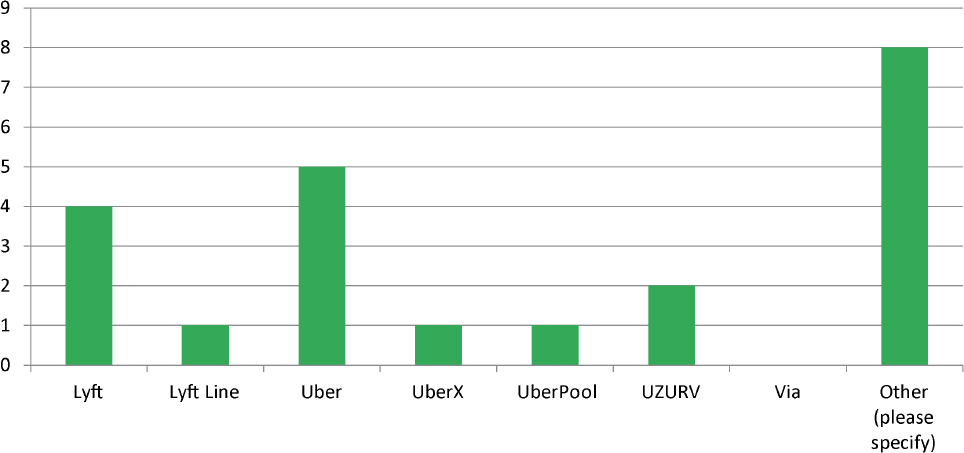
riders who need a WAV: “Lyft and Uber have very few wheelchair-accessible vehicles. We do not recommend Lyft and Uber if you use a wheelchair. If you use a wheelchair, we recommend using United Taxi.”
Fare Policy
The most common policy requires eligible riders to pay an initial fare and then any excess over a defined dollar amount (16 respondents).
- Nine require an initial fare and payment of any excess over a specified dollar amount.
- Two provide a monthly allotment to use for transportation service; one provides an 80% subsidy for up to $300 per month and the second a 50% subsidy for $80 per month.
- Two require only an initial fare.
- One requires an initial fare that provides for 5 miles and then $1.00 per mile over 5 miles.
- One has no initial fare but riders pay for any excess over the trip subsidy of $18.
- One program did not require a fare at the time of the survey, given complications with the transit agency’s fare policy and payment structure.
Trip Limits for Riders’ Use?
Half of the survey respondents have no trip limit and the other half do (16 respondents).
- Eight programs were established with no trip limits for riders.
- Six programs have a uniform limit for all riders.
- Two have a trip limit established for each rider based on that rider’s use of the ADA paratransit service.
Reasons for Trip Limits
Responding transit agencies may have limited budgets for their alternative service and in some cases have determined they did not want to subsidize a significant number of new trips that would otherwise be made on ADA paratransit (seven respondents).
- Four reported no desire to subsidize a significant number of new trips and one of the four also reported a limited budget for the program.
- Two reported a limited budget.
- One wrote in the “other” response option that “passengers were taking advantage of the program.”
Service Area
The more common service area for the alternative service reported by the survey respondents is an extended ADA paratransit service area, which is sometimes referred to as a premium service area. This allows the ADA paratransit riders to travel beyond the area the ADA requires in addition to their ability to book same-day on-demand, which is also beyond what the ADA requires (18 respondents).
- Seven serve an extended or premium service area.
- Four report serving anywhere within the county or the transit agency’s service area.
- Two serve only the ADA paratransit service area as defined by ¾-mile corridors around fixed routes.
- One serves the ADA paratransit service area plus a limited number of transit agency-designated destinations beyond the ADA paratransit service area.
- Four described “Other” approaches that are particular to the transit agency, including one agency that allows eligible riders to take trips anywhere as long as the trip starts or ends in the transit agency’s defined service area boundary.
Service Span
Based on the surveys, the more common policies for the alternative service days and hours include allowing trips 24/7 or allowing trips only during the days and hours for ADA paratransit (18 respondents).
- Seven operate 24/7.
- Six match days/hours with those for ADA paratransit.
- Two have days/hours less than ADA paratransit.
- One reports operations beyond those for ADA paratransit.
- Two report “Other”; one of these programs operates in a large metro region and the service spans vary somewhat by jurisdiction within the region.
Trip Booking and Booking/Reservation Policies
Three transit agencies reported that the only way to book trips is through the paratransit call center. Four reported that the only way is to use a call center other than the transit agency’s or a concierge service. The remaining transit agencies indicated multiple ways for eligible riders to book or obtain trips, giving eligible riders options. Figure C-10 shows the multiple responses; responses are also shown in table format in the “Data Tables for Bar Charts” section.
Most of the surveyed transit agencies provided multiple responses to the question that asked about booking alternative service/reservation policies. Not surprisingly, the most frequent response was that riders can book trips on the day of service for an immediately fulfilled trip. Two transit agencies reported that there is a minimum 1-to-2-hour advance notice for same-day trip requests.
Figure C-11 shows all the responses, with all but 3 transit agencies reporting more than one response. Responses are shown in table format in the “Data Tables for Bar Charts” section.
Data and Data Sharing
Particularly in the early years of transit agency and TNCs partnerships, the issue of data sharing was a topic of concern, as the TNCs were generally not providing transit agencies with
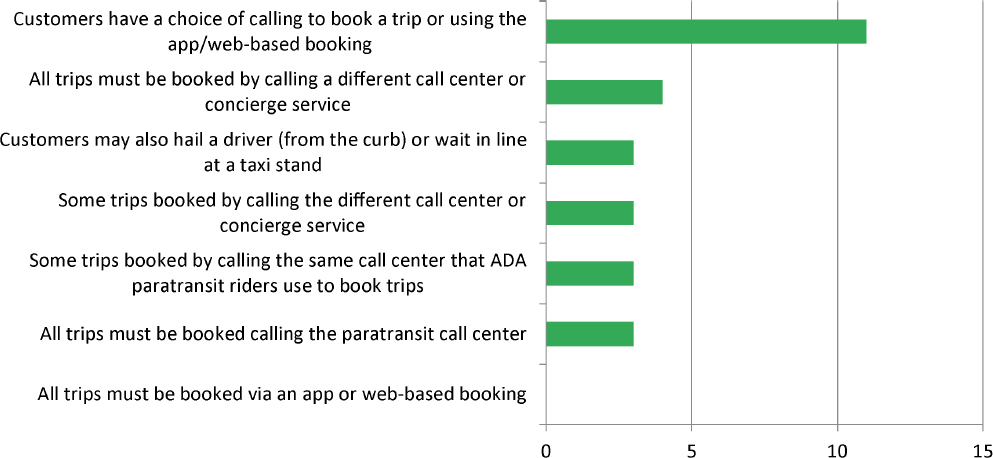
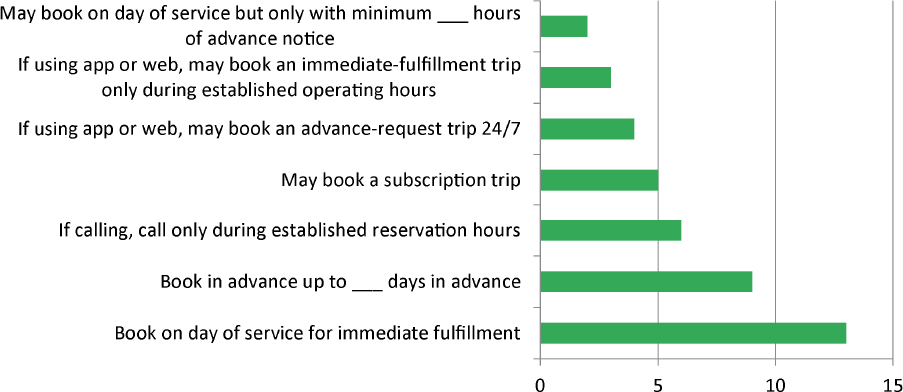
all the data that had been requested. Recent research suggests this issue is now less prominent (Shurna and Schwieterman 2020). This finding is supported by one of our provider interviews, where the TNC representative acknowledged that transit agencies need data for the services provided for paratransit riders.
Beyond the issue of NTD data discussed earlier in this appendix, the survey asked respondents if their alternative service providers were supplying them with requested data. More than half of respondents to this question reported that they were receiving all the data they requested. The remaining transit agencies reported that their providers supplied some of the requested data (15 respondents).
Specific data requested and not provided, according to the survey, include:
- Uber and Lyft have both refused to provide data to the granularity requested e.g., exact origin and destination, exact duration of trips.
- Alternative service providers are not able to provide passenger mile data as defined by NTD.
- Do not receive data to the level of detail desired, including data on trip origin and destination, rider’s name, trip duration, and trip miles.
- Data reported by client name. Wait times.
Findings from Provider Interviews
According to the provider interviews, all five providers reported no issues with providing data to their transit agency clients. The typical response was “we give the transit agency the data they want.” One of the TNCs stated that it recognizes that transit agencies need data for their alternative services and that data privacy is not as important with service for paratransit riders as it is with microtransit.
Aggregated Data
The data items total cost (subsidy) and total passenger trips provided are the two most common data items tracked by the transit agencies that reported aggregated data collected for their alternative service. Five transit agencies reported tracking data on passenger trips by vehicle type—sedan versus WAV. Only two reported tracking on-time performance data showing response times broken down by trips provided by sedans versus trips provided by WAVs. See Figure C-12 and the table in the “Data Tables for Bar Charts” section.
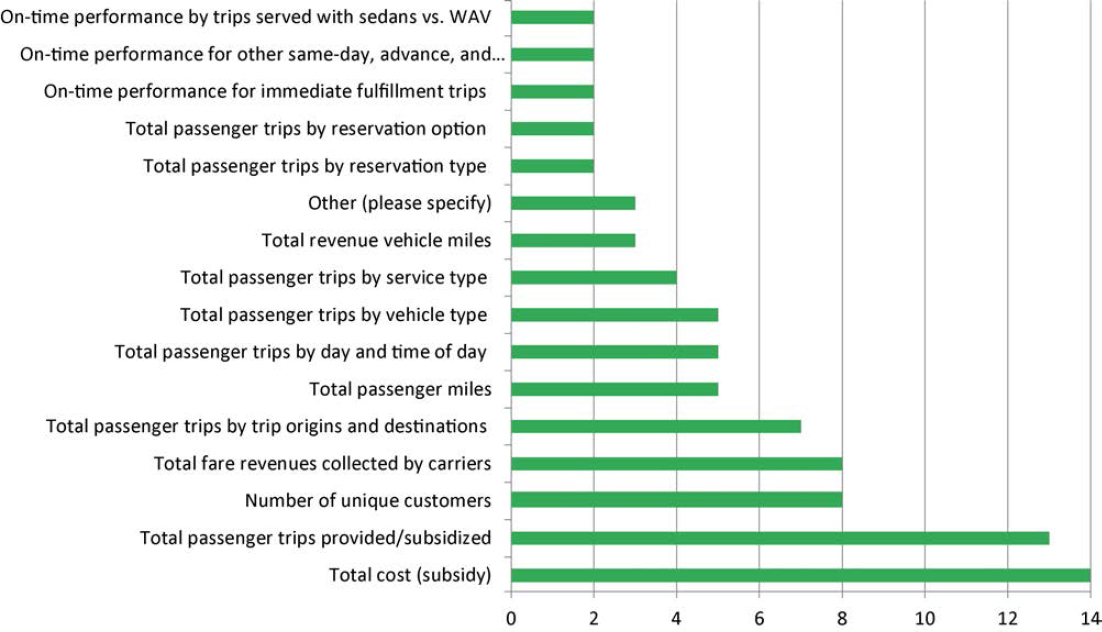
Disaggregated Data
Regarding disaggregated data tracked, total passenger trips requested/served for each rider was the most frequently reported data item—by 10 respondents. Data on passenger trip origins and destinations (seven responses) and details on passenger trips requested/served for each rider (six responses) are two additional data items that are tracked by some of the transit agencies. See Figure C-13 and these data in table format in the “Data Tables for Bar Charts” section.
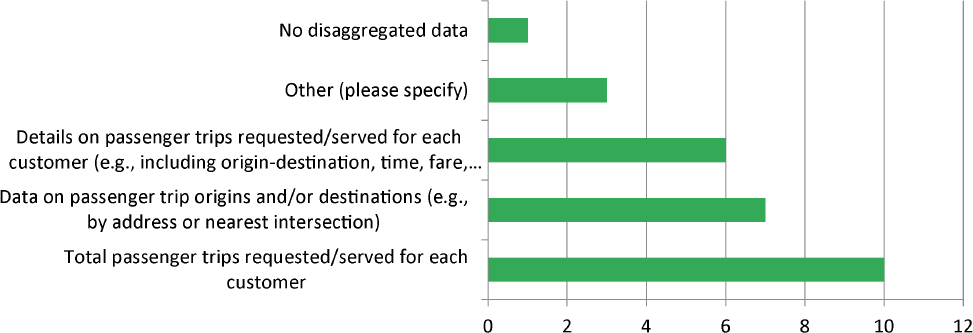
Service Statistics and Performance
The survey asked responding transit agencies for selected data for their alternative service programs for FY 2019, including:
- Passenger trips provided, for both ambulatory trips and wheelchair trips
- Total subsidy—the transit agency’s payment to the alternative service provider(s) less any fare revenue collected
- Total number of passenger miles
- Two performance measurements
- On-time performance (more appropriately termed response time for on-demand service), differentiated between ambulatory and wheelchair trips
- Complaint frequency
Thirteen of the responding transit agencies provided data, though in most cases, only partial data were reported. Total passenger trips provided was the most frequently reported data item, followed by total subsidy. Half of the transit agencies provided data on wheelchair trips. On-time performance/response time data was provided by only one transit agency—for overall service.
Table C-1 presents two key alternative service statistics reported by the transit agency survey respondents—the total passenger trips and total subsidy for their alternative service. From these two data points, the subsidy per alternative service passenger trip is computed. This ranges from a low of $9.48 in Houston to $37.12 in New York City. Also shown in Table C-1 are the data reported by the transit agencies on number of registered and active ADA passengers. The last column in the table provides data from NTD’s 2019 report year for the cost per demand response trip. This provides a contrast to the computed subsidy per alternative service passenger trip shown in the table. Note that the transit agencies are ordered in the table starting from the largest number of passenger trips reported on the alternative service.
Evaluating the Alternative Service
Goal Achievement Reporting
The transit agencies were asked if they were able to determine—with the data they tracked and/or received from their alternative service providers—whether or not they achieved their goals for the service (15 respondents).
- 12 answered “yes”
- Remaining three said “partially”
Metrics Used to Evaluate the Alternative Service
Of the measures that are used to evaluate the alternative service, the three most frequently reported were overall cost per passenger, overall cost, and overall ridership. Figure C-14 shows the responses, with the data provided in table format in the “Data Tables for Bar Charts” section.
Rider Surveys?
Of 15 responses to the question asking if riders have been surveyed about the alternative service, nine transit agencies said “yes” and six said “no.”
Method for Estimating Cost Reductions from the Alternative Service?
The survey asked if the transit agencies have a method to estimate any cost reductions from a mode shift—that is, trips that would otherwise have been made on ADA paratransit but were
Table C-1. Reported data on alternative services and number of ADA paratransit customers with NTD data on cost per demand-response trip.
| Transit Agency Location | Transit Agency | ADA Paratransit Customers, B-48 Survey Data | Alternative Service Program, B-48 Survey Data | NTD Report Year 2019: Reported Operating Expense per Unlinked Demand Response Passenger Trip | |||
|---|---|---|---|---|---|---|---|
| Registered | Active | Total Passenger Trips | Total Subsidy | Subsidy per Passenger Trip | |||
| New York, NY | MTA NYCT | 163,477 | 153,901 | 1,062,850 | $39,449,371 | $37.12 | $106.96 |
| Boston, MA | MBTA | 45,000 | 25,000 | 260,914 | $4,019,914 | $15.41 | $69.11 |
| Houston, TX | METRO | 19,000 | 12,642 | 167,186 | $1,585,434 | $9.48 | $30.76; taxi $12.52 |
| Dallas, TX | DART | 11,846 | 4,596 | 66,331 | $1,409,534 * | $21.25 * | $47.23; taxi $46.86 |
| Monterey, CA | MST | 2,789 | 2,789 | 51,000 | $35.66 | ||
| Contra Costa Co., CA | ECCTA-Tri Delta Transit | 3,700 | 2,700 | 43,936 | $491,532 | $11.19 | $27.23; taxi $10.95 |
| Richmond, VA | GRTC | 5,306 | 3,000 | 31,382 | $433,241 | $13.81 | $20.51 |
| Broward Co., FL | BCT | 16,000 | 7,700 | 19,639 | $253,659 | $12.92 | $33.34 |
| Columbus, OH | COTA | 5,200 | 1,800 | 15,169 | $467,589 | $30.83 | $38.59 |
| Pinellas Co., FL | PSTA | 10,000 | 3,575 | 13,267 | $22.22; taxi $14.68 | ||
| Flagstaff, AZ | Mountain Line | 426 | 200 | 8,070 | $102,888 | $12.75 | $52.12 |
| Las Vegas, NV | RTC | 21,000 | 9,000–12,000 | 4,856 | $45.04 | ||
| Chicago, IL | Pace | 40,000 | 40,000 | $41.95; taxi $42.12 | |||
| Denver, CO | RTD | 120,000 | 8,500 | $45.26 | |||
| Phoenix, AZ | Valley Metro | 22,000 | 9,452 | $55.75 | |||
| San Antonio, TX | VIA | 17,000 | 8,000 | $73,364 | $41.47; taxi $15.78 | ||
| San Bernardino, CA | Omnitrans | 4,000 | 2,500 | $45.74 | |||
| Washington, DC | WMATA | 49,000 | 26,000 | $70.58; taxi $137.08 | |||
* $21.25 is cost per alternative service trip that is paid to the paratransit contractor; additional cost for contractor and agency
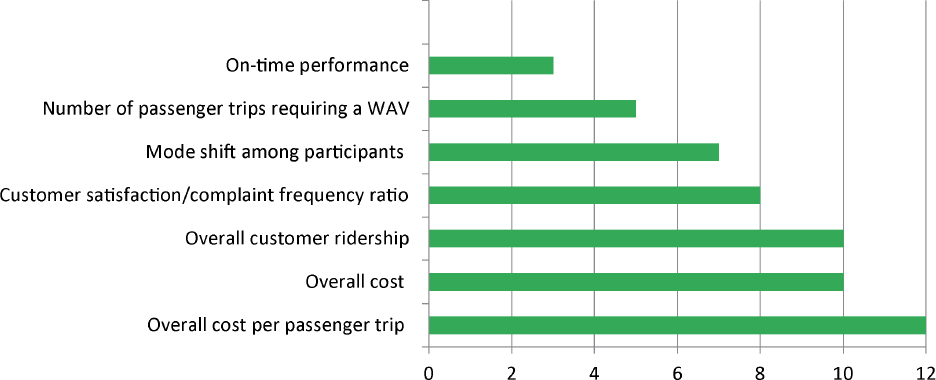
taken on the alternative service instead—but also taking into account the additional subsidy for the “new” alternative service trips (14 responses).
- Eight transit agencies replied “yes.”
- Five said “no.”
- Two were “not sure.”
For the eight agencies indicating they have a method to estimate cost reductions, the given methods were:
- Report cost savings of both TNCs in comparison with ADA paratransit on a monthly basis.
- We continue to review the program, we have seen trends, most notably induced demand due to the flexibility, where trip levels exceeded previous usage.
- Comparing ridership prepilot to ridership during the pilot.
- Match cost per passenger ($35 for para, $12 for MOD).
- We’ve compared whether aggregate per-client travel increased or decreased over time (trips per month) for each service, but the goal with On-Demand was unit cost reduction more than overall cost reduction (we want to increase capacity per dollar).
- Based on the consistency of passengers taking their regularly scheduled trips, e.g., work, dialysis, to the alternative services, the transit agency can confidently use fewer dedicated vehicles and save money on the difference.
- For customers who have signed up for the program, we project out what their future usage of ADA paratransit would be post-signup for the pilot if the pilot wouldn’t have existed, and then evaluate induced demand and how many trips are shifted from paratransit to the TNCs and apply average costs per trip to all modes.
- There is a calculation performed indicating the cost if provided by the paratransit service minus the actual cost of the alternative service.
Data to Demonstrate Unit Cost per Trip Reduction?
The survey also asked if the transit agencies have data that evidences a reduction in the unit cost per trip reduction. Of 14 responses to this question, eight said “yes” and six said “no.”
Comments and Words of Wisdom
Twelve of the transit agencies responding to the survey provided additional comments and words of wisdom that might be useful to other transit agencies considering implementing an alternative service.
|
|
|
|
|
|
|
|
|
|
|
|
Data Tables for Bar Charts
These data tables contain the same information as in the bar charts that appear earlier in Appendix C.
Table for Figure C-2. What were the goals associated with implementing an alternative service? (check all that apply) n=15
| Goals | Responses |
|---|---|
| Reduce overall cost and/or unit cost per trip of transporting paratransit customers | 14 |
| Provide an on-demand/same-day mobility option for paratransit customers | 14 |
| Reduce demand for our paratransit service | 12 |
| Provide a mobility option that allows paratransit customers to travel beyond the ADA paratransit service area | 5 |
| Provide a mobility option that allows paratransit customers to travel outside of ADA paratransit service hours | 4 |
| Other (please specify) | 2 |
| Transit agency board direction/support or in-house champion for collaborating with TNCs and/or taxi companies | 1 |
Table for Figure C-3. In planning and implementing your Alternative Service, did your transit agency identify any of the following barriers, risks, or legal considerations as key challenges? (check all that apply) n=15
| Barriers, Risks and Legal Considerations | Responses |
|---|---|
| Ensuring passenger safety | 12 |
| Providing equivalency: response times for WAV trips | 11 |
| Concerns about data collection for NTD or performance monitoring | 10 |
| Ensuring that vehicles are safe | 10 |
| Limited number of local taxi cos. with WAVs | 6 |
| Burdens of compliance with state/local agencies regulating taxis & TNCs | 5 |
| Other concerns related to requirements for drug and alcohol testing | 5 |
| Providing equivalency: info & reservations for customers without smartphones | 5 |
| Concerns about tort liability to the transit agency | 4 |
| Uncertainty as to drug and alcohol testing requirements for Alt. Service drivers & other employees | 4 |
| Limited number of taxi companies in the area | 4 |
| Providing equivalency: availability of info. & reservations to customers without Internet | 4 |
| Concerns re: effect Alt. Service providers on reputation & goodwill of the transit agency | 3 |
| Concerns related to Title VI requirement | 3 |
| Limited number of local taxi companies willing to participate | 3 |
| Providing equivalency: fare collection for unbanked customers | 3 |
| Other | 2 |
| Concerns re: impact or perceived impact to union employees | 2 |
| Uncertainty as to need for more than one Alt. Service provider (FTA’s taxicab exception) | 2 |
| Limited number of TNCs in area or portions of area | 1 |
| Limited number of TNCs willing to participate in program | 1 |
| Concerns re: classifying Alt. Service workers as employees or independent contractors | 0 |
| Other concerns related to labor law, including 49 U.S.C. § 5333(b) (Section 13(c)) | 0 |
| Burdens of compliance with federal motor carrier laws | 0 |
Table for Figure C-4. Driver Training. Are drivers providing alternative services required to participate in any special training programs? n=15
| Driver Training | Responses |
|---|---|
| Yes, per the requirements in our contract | 7 |
| No, none of the drivers undergo special training | 4 |
| Other (please specify) | 3 |
| Yes, per state/municipal regulations | 1 |
Table for Figure C-5. Drug and alcohol testing. Are drivers for alternative services required to participate in drug and alcohol testing programs? n=15
| Drug & Alcohol Testing | Responses |
|---|---|
| Yes, per federal regulations | 7 |
| Other (please specify) | 2 |
| No, none of the drivers undergo drug and alcohol testing | 2 |
| Taxi drivers undergo drug and alcohol testing, TNC drivers do not | 2 |
| Yes, per state/municipal regulations | 2 |
Table for Figure C-6. Fingerprint background checks. Are drivers for alternative services required to undergo fingerprint background checks? n=14
| Fingerprint Background Checks | Responses |
|---|---|
| Yes, per the requirements in our contract | 1 |
| Other (please specify) | 1 |
| Don’t know | 2 |
| Taxi drivers undergo fingerprint background checks, TNC drivers do not | 2 |
| No, none of the drivers undergo fingerprint background checks | 2 |
| Yes, per state/municipal regulations | 6 |
Table for Figure C-7. Vehicle insurance. Does your alternative service contract/agreement require vehicle insurance coverage beyond what is required by the state or municipal regulatory body? (check all that apply) n=15
| Vehicle Insurance | Responses |
|---|---|
| Yes, required insurance is higher, but transit agency makes exception for providers showing requirements above minimum state levels are too much of a burden | 1 |
| Yes, required insurance coverage is higher & consistent with insurance coverage required for in-house or contracted ADA paratransit service | 2 |
| Other (please specify) | 3 |
| No additional insurance, other than what is required by state or municipal regulatory body | 4 |
| Yes, and the transit agency requires itself to be named as additional insured | 4 |
| Yes required insurance coverage is higher | 5 |
Table for Figure C-8. Providers for alternative service. n=18
| Provider Type | Responses |
|---|---|
| TNCs only | 6 |
| Taxis only | 5 |
| TNCs, taxis and NEMT providers | 2 |
| TNCs and taxis | 2 |
| Debit card system, using multiple providers | 2 |
| Other | 1 |
Table for Figure C-9. If you checked TNC-based subsidy program, what TNC services are available to your alternative service customers? n=11
| TNC Service | Responses |
|---|---|
| Other (please specify) | 7 |
| Uber | 6 |
| Lyft | 4 |
| UZURV | 2 |
| Lyft Line | 1 |
| UberPool | 1 |
| VIA | 0 |
Table for Figure C-10. How do your alternative service customers book trips? (check all that apply) n=18
| Booking Service | Responses |
|---|---|
| Customers have a choice of calling to book a trip or using the app/web-based booking | 11 |
| All trips must be booked by calling a different call center or concierge service | 4 |
| Customers may also hail a driver (from the curb) or wait in line at a taxi stand | 3 |
| Some trips booked by calling the different call center or concierge service | 3 |
| Some trips booked by calling the same call center that ADA paratransit riders use to book trips | 3 |
| All trips must be booked calling the paratransit call center | 3 |
| All trips must be booked via an app or web-based booking | 0 |
Table for Figure C-11. Booking alternative service/reservation policies (check all that apply). n=16
| Policy | Responses |
|---|---|
| May book on day of service but only with minimum ___ hours of advance notice | 2 |
| If using app or web, may book an immediate-fulfillment trip only during established operating hours | 3 |
| If using app or web, may book an advance-request trip 24/7 | 4 |
| May book a subscription trip | 5 |
| If calling, call only during established reservation hours | 6 |
| Book in advance up to ___ days in advance | 9 |
| Book on day of service for immediate fulfillment | 13 |
Table for Figure C-12. Reporting details: what alternative service data is tracked by your transit agency and/or contractually required to be provided by the alternative service providers? Aggregated data (check all that apply) n=14
| Data Type | Responses |
|---|---|
| On-time performance by trips served with sedans versus WAV | 2 |
| On-time performance for other same-day, advance, and subscription trips | 2 |
| On-time performance for immediate fulfillment trips | 2 |
| Total passenger trips by reservation option | 2 |
| Total passenger trips by reservation type | 2 |
| Other (please specify) | 3 |
| Total revenue vehicle miles | 3 |
| Total passenger trips by service type | 4 |
| Total passenger trips by vehicle type | 5 |
| Total passenger trips by day and time of day | 5 |
| Total passenger miles | 5 |
| Total passenger trips by trip origins and destinations | 7 |
| Total fare revenues collected by carriers | 8 |
| Number of unique customers | 8 |
| Total passenger trips provided/subsidized | 13 |
| Total cost (subsidy) | 14 |
Table for Figure C-13. Reporting details: what alternative service data is tracked by your transit agency and/or contractually required to be provided by the alternative service providers? Disaggregated data (check all that apply) n=13
| Data Type | Responses |
|---|---|
| No disaggregated data | 1 |
| Other (please specify) | 3 |
| Details on passenger trips requested/served for each customer (e.g., including origin-destination, time, fare, on-time performance, no shows, etc.) | 6 |
| Data on passenger trips origins and/or destinations (e.g., by address or nearest intersection) | 7 |
| Total passenger trips requested/served for each customer | 10 |
Table for Figure C-14. Which of the following metrics are you using to evaluate the alternative service? (check all that apply) n=14
| Metric Type | Responses |
|---|---|
| On-time performance | 3 |
| Number of passenger trips requiring a WAV | 5 |
| Mode shift among participants | 7 |
| Customer satisfaction/complaint frequency ratio | 8 |
| Overall customer ridership | 10 |
| Overall cost | 10 |
| Overall cost per passenger trip | 12 |
This page intentionally left blank.
Abbreviations and acronyms used without definitions in TRB publications:
| A4A | Airlines for America |
| AAAE | American Association of Airport Executives |
| AASHO | American Association of State Highway Officials |
| AASHTO | American Association of State Highway and Transportation Officials |
| ACI–NA | Airports Council International–North America |
| ACRP | Airport Cooperative Research Program |
| ADA | Americans with Disabilities Act |
| APTA | American Public Transportation Association |
| ASCE | American Society of Civil Engineers |
| ASME | American Society of Mechanical Engineers |
| ASTM | American Society for Testing and Materials |
| ATA | American Trucking Associations |
| CTAA | Community Transportation Association of America |
| CTBSSP | Commercial Truck and Bus Safety Synthesis Program |
| DHS | Department of Homeland Security |
| DOE | Department of Energy |
| EPA | Environmental Protection Agency |
| FAA | Federal Aviation Administration |
| FAST | Fixing America’s Surface Transportation Act (2015) |
| FHWA | Federal Highway Administration |
| FMCSA | Federal Motor Carrier Safety Administration |
| FRA | Federal Railroad Administration |
| FTA | Federal Transit Administration |
| GHSA | Governors Highway Safety Association |
| HMCRP | Hazardous Materials Cooperative Research Program |
| IEEE | Institute of Electrical and Electronics Engineers |
| ISTEA | Intermodal Surface Transportation Efficiency Act of 1991 |
| ITE | Institute of Transportation Engineers |
| MAP-21 | Moving Ahead for Progress in the 21st Century Act (2012) |
| NASA | National Aeronautics and Space Administration |
| NASAO | National Association of State Aviation Officials |
| NCFRP | National Cooperative Freight Research Program |
| NCHRP | National Cooperative Highway Research Program |
| NHTSA | National Highway Traffic Safety Administration |
| NTSB | National Transportation Safety Board |
| PHMSA | Pipeline and Hazardous Materials Safety Administration |
| RITA | Research and Innovative Technology Administration |
| SAE | Society of Automotive Engineers |
| SAFETEA-LU | Safe, Accountable, Flexible, Efficient Transportation Equity Act: A Legacy for Users (2005) |
| TCRP | Transit Cooperative Research Program |
| TEA-21 | Transportation Equity Act for the 21st Century (1998) |
| TRB | Transportation Research Board |
| TSA | Transportation Security Administration |
| U.S. DOT | United States Department of Transportation |
